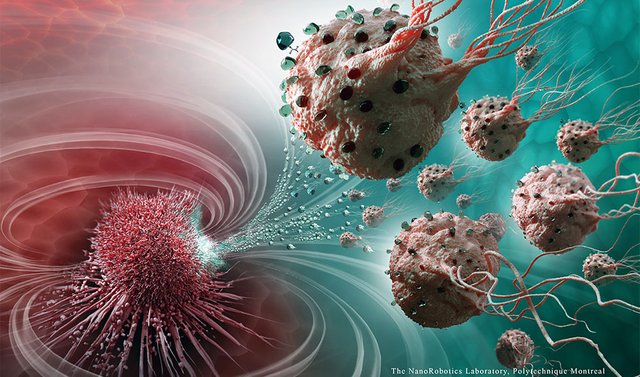Scientists Have Created Nanorobots That Can Travel Down the Bloodstream and Precisely Target Cancerous Tumors (check out the video inside!)

A new cancer research breakthrough has recently been developed thanks to researchers from McGill University, Université de Montréal and Polytechnique Montréal. The new nanorobots can travel down the bloodstream to administer drugs precisely by targeting a tumor's cancer cells. This is the best way to inject medication since the integrity of the healthy tissues and organs won't be jeopardized. This means that the dosage of the drug could be reduced, which is significant because the drug is very toxic for humans.
According to Professor Sylvain Martel, director and the head of the research team at Polytechnique Montréal Nanorobotics Laboratory and the holder of the Medical Nanorobotics Canada Research Chair, these nanorobotic agents hold no less than 100 million bacteria, which are flagellated and self-propelled. These bacteria are full of drugs and take a direct path from the injection site to the part of the body that needs to be cured. The propelling force of the drug is strong enough to enter the tumors deeply and to travel efficiently.
When the nanorobotic agents enter a specific tumor they can automatically detect the tumor areas that have been depleted of oxygen, which are called hypoxic zones, in order to deliver the medicine to them. Tumor cells that are rapidly proliferative create a hypoxic zone by substantially consuming oxygen. Up until now these hypoxic zones have been resistant to the majority of therapy methods including radiotherapy. It is difficult to access these tumors even with a small blood cell path because physiological complex microenvironments need to be crossed. For this reason, Prof. Martel along with his team of researchers decided to use nanotechnology to see results.
There are 2 natural systems that the bacteria rely on for movement. They are drawn towards a magnetic field through the synthesis created by a magnetic nanoparticles chain and they are able to get to the active regions in the tumor and remain there with an oxygen concentration measuring sensor. When these 2 systems of transportation are used together and when the bacteria are exposed to a magnetic field that is computer-controlled, these bacteria are able to replicate perfectly these task-oriented artificial nanorobots.
Prof. Martel goes on to say that more advanced intervention methods and engineering concepts will be created as a result of the innovative use of these nanorobots. As well, the synthesis of new transportation methods for diagnosing, imaging and therapeutic agents can be further researched. Chemotherapy is a toxic form of therapy for the human body and as a result of the research the side effects could be eliminated while the therapeutic effectiveness is increased by using nanorobots to directly transport the drugs to the targeted area.
The research paper has been published in the journal of Nature Nanotechnology in a study titled "Magneto-aerotactic bacteria deliver drug-containing nanoliposomes to tumour hypoxic regions." The research marks the results of the study done on mice and shows how they successfully directed nanorobotic agents into colorectal tumors.

Like what you read (without annoying ads :) ) ? Then please upvote our posts and follow us for the best daily science news on SteemIt!